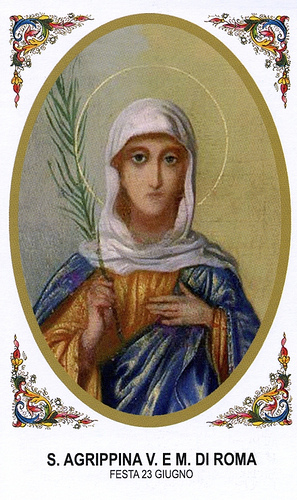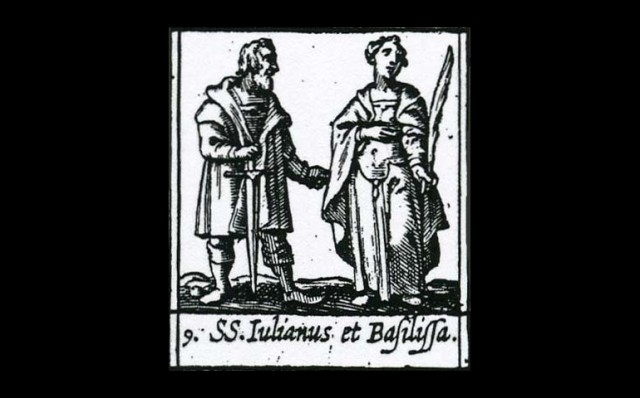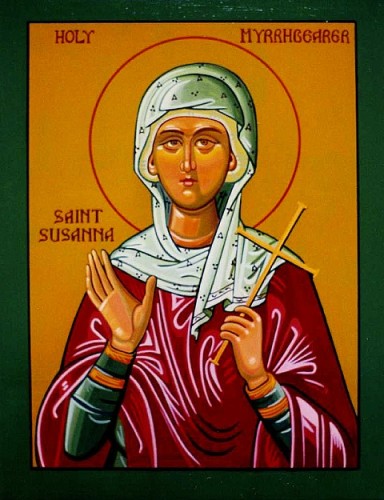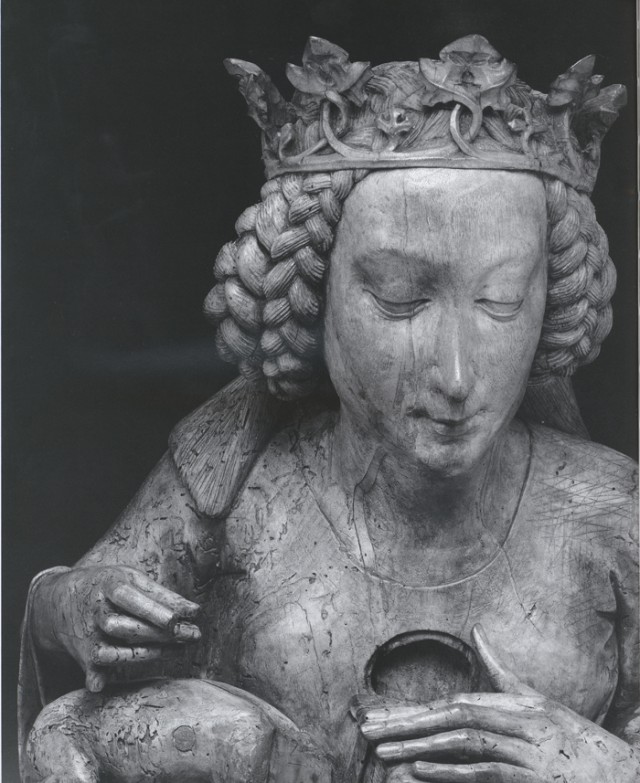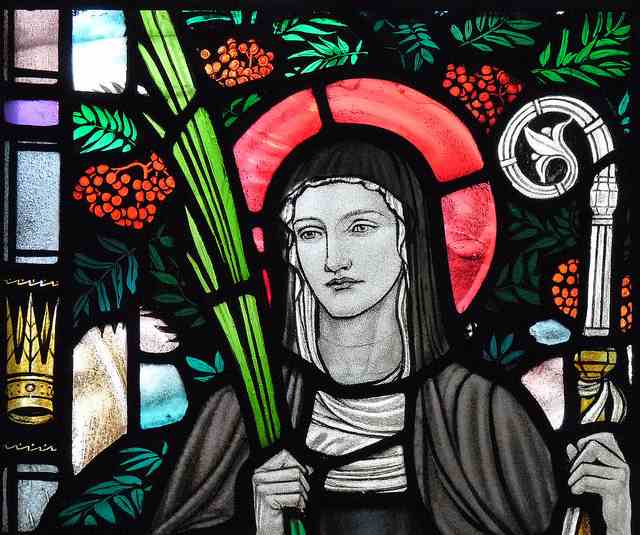Being martyred was considered the highest honor for early Christian believers who converted from paganism. And despite the risk of death, many young women were attracted to the prospect of devoting themselves to God, especially if celibacy helped them avoid an unhappy arranged marriage. Some women who were beheaded for their faith have fascinating stories behind them that should captivate both believers and non-believers.
10. Saint Afra
Known for her unwavering faith to the Christian church, Afra became a convert to the new religion after being in the service of the goddess Venus as a vestal virgin. Originally from Cyprus, her family moved to Augsburg in Bavaria, Germany, where she became dedicated to the pagan goddess of love and beauty. Her conversion came as a result of a visit from Bishop Narcissus of Gerona, Spain, who fled his country during the religious persecution of Emperor Diocletian. Diocletian was a religious conservative who declared that members and converts to the Roman Catholic church be eliminated if they refused to accept the old ways of worship.
Afra refused to renounce her allegiance to the church and was reputed to have been burned alive at the stake around 304 C.E. along with her mother and three handmaids in Augsburg by the river Lech. However, another document stated that Afra was beheaded and her body buried far away. Today the tomb of Saint Afra is in an abbey bearing her name in Augsburg.
9. Saint Agrippina
Agrippina came from Roman nobility and was reportedly very beautiful. Like many members of the nobility at the time, she dedicated her life to one of the deities of the Roman pantheon. She converted to Christianity in her youth and took a vow of chastity, which clashed with her father’s desire to marry her off to another noble.
Aggripina died in 262 C.E. after being scourged and eventually beheaded by Roman inquisitors under Emperor Valerian. Her remains were later moved to Mineo, Sicily. Her tomb has been the location of many miracles where the faithful visit her and request divine intervention, including protection from thunderstorms, and the healing of leprosy and bacterial infections. Saint Agrippina’s relics are now housed in Constantinople.
8. Saint Basilissa
Basilissa was a Roman noble who was born in the third century. Orphaned at a young age, Basilissa desired to learn about the new Christian religion and traveled to Rome. She was taught by Eugenia, another recent convert who was eventually martyred. Bailissa’s adopted family wanted her to marry a wealthy patrician named Pompeius but Basilissa refused, claiming that she dedicated herself to God.
Basilissa’s vow of celibacy was not something to be compromised. She was beheaded in 304 C.E. under the rule of Emperor Gallienus for refusing to marry and renounce her beliefs. Her remains were buried on the Via Salaria in Rome, and her sacred relics reside in the region of Brittany in northwest France.
7. Saint Cecilia
Cecilia was another noble Roman who married a man named Valerian, but on her wedding night told him the only way the marriage could be consummated was if he were to convert to Christianity. Valerian was a pagan, but Cecilia promised to still love him if he allowed her to remain chaste for God. She informed her husband that an angel guarded her body, and that if he was sincere about converting the angel would be revealed to him. Valerian converted, as did his brother Tiburtius, upon purportedly witnessing the angel who attended Cecilia.
Cecilia would go on to convert a few hundred more people, but her success eventually brought about her downfall. Her husband, Tiburtius, and herself were hunted down by Turcius, a soldier under Emperor Marcus Aurelius. All three of them were beheaded as martyrs. Poor Cecilia didn’t go out with a nice, clean cut — Turcius and his men made three attempts to behead her without avail. She continued to preach for three days until she finally succumbed to her wounds. Cecilia died in Sicily sometime between 176 and 180 C.E., and her home was eventually converted into a church.
6. Saint Dymphna
Dymphna was born in northern Ireland during the 7th century. Her mother was a Christian while her father was a pagan king of the region named Airgíalla. Dymphna became motherless at the age of 14, upon which she also dedicated herself to God and took a vow of celibacy. Her father never stopped grieving over the loss of his wife and swore he would only re-marry a woman who looked just like her. Unable to find such a woman, he turned to his daughter, but she refused. In order to preserve her chastity — and probably her sanity — Dymphna left her homeland for Gheel, Belgium and hid there.
But her father caught up with her after tracing her footsteps via the special coins she used to pay for room and board along the way. He made a final demand for marriage, and when she refused he beheaded her in a rage. At the tender age of 15 Dymphna became a Christian martyr around 620 C.E. She’s the patron saint of individuals with mental illness and incest victims. A church was built in 1349 in the city where she died, which houses her relics which are believed to heal those who have mental illnesses.
5. Saint Eurosia
Eurosia was a French girl from Bayonne during the eighth century. Born into nobility, her family arranged for her to marry a European Muslim who took a liking to her. Eurosia fled and hid in a cave in the Pyrenees. She thought she was safe until smoke from her small campfire led the Saracen troops led by her betrothed to investigate. Eurosia was dragged out of the cave and met her death by beheading in 714 C.E. Her body was buried in Jaca, a city in northeast Spain.
Eurosia is the patron saint of Jaca, where her relics are housed, and she eventually became the patron saint of those possessed by demons. It’s unclear how she became the patron saint of such individuals, but a once frequent practice had those who were believed to be possessed gather around a jar containing Eurosia’s relics in the hopes of being healed from their affliction. The Bishop of Jaca put a stop to this in 1947.
4. Saint Susanna
Susanna came from an extended Christian family — she was the daughter of Saint Gabinius, who was the brother of Pope Caius. Her home was a place of worship where Christians gathered for services during the reign of Diocletian. It wasn’t her family’s conversion of pagans to Christianity that led to her death, however. Instead, it was Diocletian’s desire for her to marry his son-in law, General Maxentius Galerius. Susanna had no intention of marrying a pagan and stated so to her family. She even converted two officers and uncles of hers sent by Diocletian to persuade her.
When Diocletian discovered what happened he sent his most efficient officer to Susanna’s house to deal with the matter. Susanna and her two uncles were all decapitated in the year 295 C.E., while her father was imprisoned and died from starvation. The house Susanna died in was later converted into a church, the Church of Saint Susanna at the Baths of Diocletian in Rome.
3. Saint Juthwara
Juthwara was born in Dorset, England some time during the sixth century. A devout Christian girl, she had to deal with a step-mother who was less than kind, and her story is one of the stranger tales of martyrdom.
When her father died Juthwara started to experience strange pains in her chest, which have been attributed to sorrow. As a cure her stepmother recommended that the girl fasten two round pieces of soft cheese to her chest. Wanting to discredit Juthwara’s piousness, her stepmother told her own son, Bana, that the girl was pregnant. Not being terribly respectful of his step-sister’s privacy, Bana felt her up and was surprised to discover that she wasn’t pregnant at all.
Upset about being lied to, Bana cut off Juthwara’s head. A spring of water supposedly appeared on the ground where her head landed, and Juthwara picked up her own head and headed to church to pray before dying. Bana witnessed the entire incident and, feeling both remorseful and no doubt a little freaked out, converted to Christianity, became a monk and founded a monastery to atone for his sins. Juthwara’s body and relics were moved to Sherborne Abbey in Dorset after her death, and annual pilgrimages are made to her tomb.
2. Saint Noyala
Noyala was born in northwest England, where her father was a king. When she turned 20 her father decided to marry his Christian daughter off to pagan royalty. To escape, Noyala and her servant left her homeland for France. It was said that the two women traveled across the English channel on a small tree branch.
Noyala found a safe refuge in Beignan, but her security didn’t last long. A local pagan governor by the name of Nisan became smitten with her and wanted to be married. Noyala refused, declaring that she was dedicated to God alone, to which Nisan responded by cutting her head off. Like Juthwara, this supposedly didn’t stop Noyala from missing a beat — she picked her head up and walked away in search of a peaceful spot to die with her faithful servant in tow. Along the way, three drops of blood spilled from her head and formed water springs.
It took her an entire night and day to reach the town of Noyale. Thinking it perfect for her final resting spot she died there, and her tomb is maintained by the chapel that was built around it, Chapel Sainte-Noyale. It’s a frequent destination for believers during Holy Week.
1. Saint Winefride
Commonly referred to as Lourdes of Wales, Winefride was the daughter of Tyfid ap Eiludd, a Welsh nobleman, and his wife Wenlo. Wenlo was the sister of Saint Beuno, whose piety influenced the girl to become a Christian and a nun. Winefride also had an abbess aunt by the name of Tenoi. Her dedication to a celibate life did not set well with Caradog, a prince whom her parents arranged her to marry. Her betrothed was so upset that he cut off her head with his sword. Winefride’s head rolled down a hill and as soon as it landed an earthquake supposedly occurred and a spring of water arose. Caradog didn’t count on Winefride’s uncle Beuno restoring her head to her body, preserving her life and no doubt making him her favorite uncle.
Winefride later became the abbess of Shrewsbury Abbey, which was eventually transformed into a church bearing her name in Gwytherin, Wales. Winefride’s bones are maintained at the church where pilgrims travel to be healed by the spring of water that was turned into a well. There’s an unusually large amount of historical evidence for Winefride’s existence, particularly medieval manuscripts that mention a large scar across her neck.

